|
|
|
Sort Order |
|
|
|
Items / Page
|
|
|
|
|
|
|
| Srl | Item |
| 1 |
ID:
173095
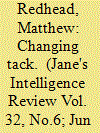

|
|
|
| 2 |
ID:
140984
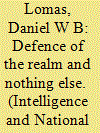

|
|
|
|
|
| Summary/Abstract |
In May 2013, a report on the British Security Service (MI5) by Sir Samuel Findlater Stewart was released by the Cabinet Office. Dated November 1945, the report on the future organization and activities of MI5 was significant in that it defined the Service's post-war remit, accountability and relations with the Secret Intelligence Service (SIS), laying the groundwork of MI5's mandate until the introduction of the Security Service Act in 1989. The article also suggests that the report is significant, not just because it sheds important light on MI5's wartime and post-war role, but because it helps question existing assumptions about the relationship between the Security Service and the post-war Labour Government of Clement Attlee, often viewed as a troubled one.
|
|
|
|
|
|
|
|
|
|
|
|
|
|
|
|
| 3 |
ID:
092466
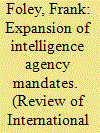

|
|
|
|
|
| Publication |
2009.
|
| Summary/Abstract |
The UK's domestic intelligence agency, MI5, has become increasingly involved in the realm of law enforcement over the last decade. This article puts the British experience in perspective by comparing it with France's main domestic intelligence agency, which has pushed deep into the law enforcement arena in recent years. A similar perception of Islamist terrorism underpins these parallel developments in the two countries. However, differences relating to accountability, legal systems and conceptions of the state mean that the French intelligence agency has expanded its role considerably more than its British counterpart. The analysis indicates that MI5's move into law enforcement is likely to remain a relatively conservative one.
|
|
|
|
|
|
|
|
|
|
|
|
|
|
|
|
| 4 |
ID:
119414
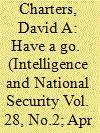

|
|
|
|
|
| Publication |
2013.
|
| Summary/Abstract |
Early in the Northern Ireland conflict the army took the lead in intelligence operations, including Humint. This article examines the case of 'Observer B', an agent run jointly with MI5. Using testimony and documents provided to the Bloody Sunday Inquiry as well as original archival sources, it offers a unique Humint case study that discusses the agent's recruitment, motivation, reliability, handling, product, and utility. This represents the most complete account that we have of this case, but gaps remain. It illustrates some of the limitations of clandestine Humint collection in situations where information may be time-sensitive. The article challenges the conventional wisdom about army/MI5 relations and shows how the two improvised and cooperated in agent-running.
|
|
|
|
|
|
|
|
|
|
|
|
|
|
|
|
| 5 |
ID:
092975
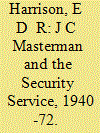

|
|
|
|
|
| Publication |
2009.
|
| Summary/Abstract |
The significance of J.C. Masterman's relationship with the Security Service, MI5, has not been fully appreciated. As a junior officer during World War II, he consistently sought to achieve good working relations with the Secret Intelligence Service. After the war he continued to take an interest in the Security Service and worked closely with other MI5 elder statesmen to ensure that the successor to Percy Sillitoe as Director-General came from within the Service. Masterman always hoped that his account of the double agents run by British Intelligence during World War II would one day be published. As the public image of the British secret services deteriorated during the 1960s, Masterman believed that MI5 did not grasp how his book could promote its interests, and so he insisted on forcing through publication anyway. The correspondence from serving and former MI5 officers in Masterman's papers vividly illustrate changing attitudes to official secrecy and the declining ability of the British Government to enforce it.
|
|
|
|
|
|
|
|
|
|
|
|
|
|
|
|
| 6 |
ID:
140986


|
|
|
|
|
| Summary/Abstract |
From 1941 to 1944, MI5 faced determined attempts to penetrate Allied Air Forces using trained pilot agents recruited by German Military Intelligence (Abwehr). The mission of these pilot agents was to gather military intelligence and to return to German held territory. This pattern of targeting Allied Air Forces has not been recognized by historians. This article examines MI5's responses to the threat using recently released files in the National Archives.
|
|
|
|
|
|
|
|
|
|
|
|
|
|
|
|
| 7 |
ID:
154863


|
|
|
|
|
| Summary/Abstract |
From 1946–1963, MI5 operated a South-East Asian regional headquarters in Singapore: Security Intelligence Far East (SIFE). This article responds to growing interest in theatre-level intelligence organisation and the importance of intelligence to Britain’s Cold War and decolonisation by examining the performance of SIFE. On the organisational level, SIFE was strongest when it remained wedded to its charter functions and closely adhered to the priorities of its principal consumer: the Commissioner-General for South-East Asia. Its assessments were influential in shaping decision-makers’ understandings of key regional developments, although this did not always translate into public policy. Lastly, SIFE enjoyed success in developing lasting liaison relationships to cement British influence, but failed to utilise these to improve its intake of raw intelligence.
|
|
|
|
|
|
|
|
|
|
|
|
|
|
|
|
| 8 |
ID:
158763
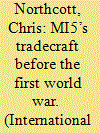

|
|
|
| 9 |
ID:
059622


|
|
|
|
|
| Publication |
London, William Heinemann Ltd., 1985.
|
| Description |
xviii, 619p.hbk
|
| Standard Number |
0434021105
|
|
|
|
|
|
|
|
|
|
|
|
Copies: C:1/I:0,R:0,Q:0
Circulation
| Accession# | Call# | Current Location | Status | Policy | Location |
| 031054 | 327.120941/AND 031054 | Main | On Shelf | General | |
|
|
|
|
| 10 |
ID:
038761


|
|
|
|
|
| Publication |
New York, Viking, 1987.
|
| Description |
392p.Hbk
|
| Standard Number |
0670820555
|
|
|
|
|
|
|
|
|
|
|
|
Copies: C:1/I:0,R:0,Q:0
Circulation
| Accession# | Call# | Current Location | Status | Policy | Location |
| 028992 | 920.932712/WRI 028992 | Main | On Shelf | General | |
|
|
|
|
| 11 |
ID:
124575
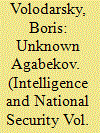

|
|
|
|
|
| Publication |
2013.
|
| Summary/Abstract |
The decision to declassify selected historical documents from the archives of the Security Service in 1997 has been a boon to academic historians of intelligence. The declassified files reveal the successes and failures of the Security Service in fulfilling its statutory function of defending the realm. Yet the activity of Soviet spies continues to be one of the most challenging topics in intelligence history. The role of Soviet defectors in transforming the Security Service's understanding of the nature and extent of Soviet intelligence operations, meanwhile, remains largely understudied. In the case of Agabekov, for example, the reaction of SIS or MI5 to his 'disappearance' in the spring of 1938 has long been neglected. It is possible that there was no reaction at all, because both services had long-since written off Agabekov as a source. This helps explain why Agabekov's case has been ignored in the relevant literature in both Russia and the West.
|
|
|
|
|
|
|
|
|
|
|
|
|
|
|
|
| 12 |
ID:
146424


|
|
|
|
|
| Summary/Abstract |
In the 1940s and early 1950s a Soviet KGB1 mole, Kim Philby, indisputably penetrated the heart of MI6, the Secret Intelligence Service espionage arm of British Intelligence. Furthermore, suspicions continue that the Security Service (MI5), the counterespionage arm of British Intelligence, was also penetrated during the same period. When a group of highly experienced senior members of MI5 came to believe in the 1960s and 1970s that a Soviet mole operated within their own senior ranks, a number of secret investigations were approved within the service. The two principal candidates to emerge as the possible “super” mole were Roger Hollis and Graham Mitchell, who at the time were its Director General and Deputy Director General respectively, but no clear evidence was ever found, or has since been uncovered, of either man’s guilt.
|
|
|
|
|
|
|
|
|
|
|
|
|
|
|
|
|
|
|
|
|